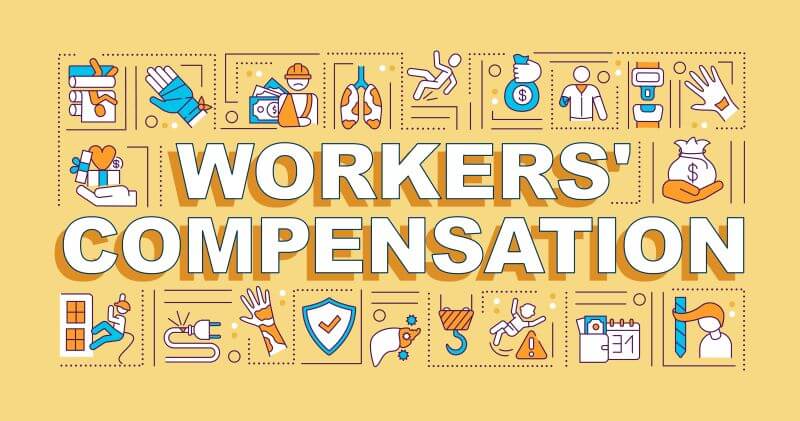What is workers compensation insurance? In essence, it’s a mandatory protection scheme that covers medical expenses and lost wages for employees hurt or sickened on the job. It’s vital for both workers’ welfare and employers’ peace of mind. Ready to understand its workings, benefits, and why every employer should be well-acquainted with it? Dive into our comprehensive guide for all the essentials and beyond.
Key Takeaways
- Workers’ compensation is a mandatory program that provides benefits to employees who suffer work-related injuries or illnesses, including coverage for healthcare, lost income, rehabilitation, vocational training, and death benefits.
- The workers’ compensation system is based on a no-fault principle that allows employees to receive benefits regardless of who is at fault for the injury, avoiding the need for litigation and providing protection for both the employer and employee.
- State-specific regulations significantly affect the administration of workers’ compensation, mandating which employers need to provide coverage and defining the eligibility of workers, while factors like the nature of employment, payroll size, and claims history influence insurance premiums.
Demystifying Workers’ Compensation Insurance

Workers’ compensation is a government-mandated program designed to provide safety net benefits to employees who experience work-related injuries or illnesses. This form of insurance covers a broad spectrum of costs that can arise following a workplace incident, including:
- Medical care
- Rehabilitation services
- Lost wages
- Vocational training
- Death benefits for dependents
Workers’ compensation is intended to protect both employees and employers by providing financial support and ensuring that the injured or ill employee receives the necessary care and support to recover and return to work.
Think of workers’ compensation as a two-way street. Employees are assured of support in the event of a work-related injury, while the employer is protected against potential lawsuits. This arrangement, governed by workers compensation law, creates a win-win situation: employees receive the necessary care and financial support, and businesses are shielded from the high costs and complications of litigation. The workers comp system plays a crucial role in maintaining this balance.
Remember, workers’ compensation extends beyond being an insurance policy; it plays a vital role in fostering a stable and secure work environment between the employer and its employees. That’s why it is a law that the employer carries workers compensation insurance or offers an alternative option for workers to receive legally required benefits.
The Anatomy of Workers’ Compensation Coverage

Workers’ compensation insurance is a safeguard that provides a range of benefits when an employee sustains a work-related injury or illness. This coverage might include everything from partial wage replacement to ongoing care or medical costs, all designed to support the employee during their recovery. When it comes to purchasing workers compensation insurance, it’s essential to choose the right policy for your business to ensure the best protection for your employees.
How does this coverage manifest in real-world scenarios? We’ll dissect it into three primary components: healthcare expenses and rehabilitation costs, lost income and income support, including disability benefits, and death benefits for dependents.
Medical Care and Rehabilitation Costs

When a workplace injury occurs, the priority is to ensure the employee receives appropriate medical treatment. Workers’ compensation insurance covers everything from immediate professional medical care to onsite first aid and subsequent benefit payments for an injured worker. But the support doesn’t stop there.
The insurance also covers physical rehabilitation, including short-term therapeutic services and post-surgical therapy, to help injured employees regain mobility. Moreover, if a worker’s injuries prevent them from returning to their previous job, the insurance provides vocational rehabilitation, such as job training and application assistance. This comprehensive approach to care ensures that injured employees are supported throughout their recovery journey, from immediate medical treatment to rehabilitation and return to work.
Lost Wages and Income Support

Although healthcare is vital, it forms just one aspect of the whole picture. For numerous injured employees, the potential income loss during their recovery time poses a substantial worry. Enter workers’ compensation. This insurance provides about two-thirds of an employee’s average weekly wages in the form of benefit payments when they’re unable to work due to a job-related or an on-the-job injury.
The specifics can vary by state, but the goal remains the same: to provide financial stability during a challenging time. For those who can return to work but at a reduced capacity, workers’ compensation provides benefits covering the difference between their previous and reduced wages. This income support ensures employees can focus on recovery without worrying about their financial stability.
Death Benefits and Dependents

The unfortunate reality is that some workplace injuries can be fatal. In these cases, workers’ compensation provides financial support to the deceased worker’s dependents. Eligibility typically depends on financial dependency on the deceased worker, such as a spouse or children under 18.
Death benefits cover funeral and burial expenses, typically ranging between $5,000 and $10,000. In addition, dependents may receive weekly payments equal to two-thirds of the deceased worker’s average weekly wage. These benefits provide a crucial financial lifeline to families dealing with the loss of a loved one.
The No-Fault System Explained
One distinctive feature of workers’ compensation is its ‘no-fault’ mechanism. It implies that employees can avail benefits irrespective of who is responsible for the work-related injury or illness. The no-fault system accelerates the provision of workers’ compensation benefits by removing the requirement for a civil lawsuit resolution.
For employers, the no-fault system offers legal protection, preventing the employee from pursuing a civil lawsuit for workplace injuries. This system promotes a more direct and predictable resolution, ensuring employees injured receive benefits promptly without lengthy legal battles.
Employer’s Obligations and the Role of Insurance Companies
Employers hold a pivotal position in the workers’ compensation framework, bearing the responsibility of:
- Procuring workers’ compensation insurance
- Guaranteeing healthcare for injured workers
- Reporting workplace injuries
- Complying with state laws, including posting notices of compliance at job sites
Meanwhile, insurance companies manage workers’ compensation claims, verifying work-related injuries or illnesses and deciding on benefits based on the specific claim. By working together, the employer and insurance company together ensure that injured workers receive the support they need.
Reviewing Workers’ Compensation Policies
Workers’ compensation programs and policies should be reviewed on a consistent basis, but at least annually. The frequency may depend on several factors, such as:
- Your workers comp program’s complexity
- Changes in OSHA standards that affect your company
- The risk and type of hazards typical in your industry
- The number or frequency of incidents at your company
- Medical evidence of continued sickness or injury on which the claims are based
- Purchases or discontinuation of equipment and machines, or processes to run them
- How soon employees typically return to work after claims
You can coordinate with your human resources manager to conduct a workers’ comp review at the end of each year, or schedule it at the same time as performance reviews.
State-Specific Workers’ Compensation Laws
Workers’ compensation doesn’t adopt a uniform approach. Each state establishes specific regulations to dictate which employers are obligated to provide workers’ compensation insurance and which workers’ categories are eligible for coverage. This means that the specifics of workers’ compensation coverage can vary significantly depending on where a business operates.
These variations reflect differences in state labor demographics and risk assessments, leading to differences in how each workers compensation premium is calculated and the benefits provided. Understanding state-specific rules is crucial for both employers and workers to ensure they are fully aware of their rights and obligations under workers’ compensation laws.
Navigating Complexities: Staffing Agencies and Workers’ Comp
Working at a staffing agency adds a layer of complexity to workers’ compensation issues. Staffing agencies purchase different types of workers’ comp insurance policies. This can affect the costs for their services as well as the coverage types they offer to temporary workers.
Before contracting with a company, the agency should research the company’s comp codes. They can use the codes to determine markup rates or if the company is even serviceable under their insurance.
While one agency might be more expensive than another, the less expensive agency might not adequately cover the temp employees at their business due to their comp code.
It is extremely helpful when agencies meet with potential new clients and they know their work comp code so the agency doesn’t have to guess and has the most accurate information to make business decisions moving forward.
Staffing Agencies and OSHA Incident Logs
Another aspect of working with staffing agencies that provide workers compensation coverage concerns OSHA incident logs. While staffing agencies pay for and carry workers compensation insurance for their temp employees, any workplace injury involving a temp employee will be recorded on the client company’s OSHA incident log, not that of the staffing agency. This is a distinction that most employers who hire workers through temp agencies may not realize.
This can hurt staffing agencies when it comes to keeping temp workers safe and paying for unemployment insurance. The cost of work comp insurance fluctuates based on the number and severity of injuries that occur. If the numbers rise, so does the cost of the insurance. If the numbers fall, so does the cost of the insurance! Unfortunately, the company is responsible for implementing measures to reduce injuries on the job. If they don’t do their part, temp workers can pay the price and the staffing agency ends up paying the higher insurance cost.
Recordkeeping Responsibility
To clarify the responsibility for recordkeeping if one or more employees is injured in an agency arrangement, OSHA created rules to address this situation. They state that as long as the host employer has day-to-day supervision over the worker, then the host employer must also record any injuries or illnesses for that worker. This is true even if the staffing agency has its own representative at the worksite.
Understanding these nuances is crucial for business operations when navigating the complexities of staffing agencies in relationship to a work-related incident and workers’ comp.
The Cost Factor: Calculating The Workers’ Compensation Premium
Businesses significantly compare and analyze the insurance and loss costs of workers’ comp insurance. Several factors determine the premiums, such as the nature of employment, the magnitude of the employer’s payroll, and the company’s history with claims.
A company’s experience modification rate (EMR) reflects its safety record and claims history. It plays a crucial role in determining premiums. By implementing safety protocols and procedures, businesses can improve their EMR and reduce their workers’ compensation premiums. Understanding these factors can help businesses strategically manage workers’ compensation costs for their labor force.
The Claims Process: From Injury to Resolution

The workers’ compensation claims process might appear complicated, but fundamentally, it is a sequential procedure tailored to aid an injured employee. It begins with the employee reporting the injury or illness to their employer and filing a claim with the Workers’ Compensation Board.
Once a claim is made, it goes through the following process:
- The workers’ compensation carrier assesses the claim and verifies the injury.
- The carrier develops a return-to-work plan for the employee.
- The case is resolved either through the employee’s return to work or by reaching maximum improvement of their health.
Who Is Covered Under Workers’ Compensation?
So, who qualifies for workers’ compensation coverage? Generally, the following workers gain coverage, given that the injury or illness is job-related, and all reporting and submission deadlines are fulfilled:
- Full-time workers
- Part-time workers
- Seasonal workers
- Temporary workers
However, not all people who work are covered. Contractors, freelancers, sole proprietorship business owners, or workers in specific professions may be exempt from workers’ compensation coverage. Other professions such as real estate agents might not receive coverage unless the agency has at least 3 full-time employees. Understanding these variances is crucial for employees and employers alike to ensure they are adequately protected.
When Businesses Opt to Self-Insure
Some enterprises might opt for self-insurance, effectively assuming the financial liability of disbursing workers’ compensation benefits directly. This option can offer cost control and cash flow benefits, making it an attractive choice for some businesses.
However, most employers agree that self-insurance isn’t for everyone. Smaller businesses or those with less stable cash flows may find the financial risks too unpredictable. On the other hand, larger businesses with steadier cash flows may be better equipped to handle these risks.
To limit their financial exposure, self-insured employers often purchase excess insurance covering unusually large claims. This can also be a viable option for small businesses looking to self-insure but wanting to protect against significant unplanned expenses.
Summary
We’ve traversed the landscape of workers’ compensation insurance, demystifying its complexities, and illuminating its benefits. From the anatomy of coverage to the unique considerations of staffing agencies, we’ve explored the critical facets that define this vital safety net for employees.
Understanding workers’ compensation insurance is crucial, whether you’re an employer looking to protect your business and its labor force or an employee seeking to understand your rights. As you navigate the world of work, remember: Knowledge is power. Understanding workers’ compensation insurance gives you the power to protect your interests and those of your workers.
Frequently Asked Questions
What is a workers compensation insurance policy used for?
Workers’ compensation insurance assists in providing medical care, replacement of lost wages, and disability benefits to workers who are injured or become ill due to their job. It also offers benefits to the families of employees who die due to work-related injuries or illnesses. This insurance protects the employer from claims by an employee who experiences work-related injuries.
Which situation qualifies an employee for workers compensation coverage?
Workers qualify for workers’ compensation coverage if they are employees (not independent contractors), their employer carries workers’ compensation insurance, and they experience an injury, occupational disease, or illness that is a direct result of their work environment. This could include a single work-related event or the development of an illness due to work conditions.
What does workers compensation in US healthcare provide?
Workers’ compensation in US healthcare provides cash benefits or healthcare to workers who suffer an injury or become ill due to their workplace. It is effectively a disability insurance program primarily handled by individual states.
Who is covered under workers compensation?
Most full-time, part-time, seasonal, and temporary workers are covered under workers’ compensation, while exemptions may apply for contractors, freelancers, and certain professions.


